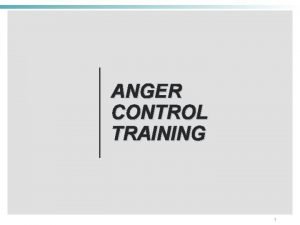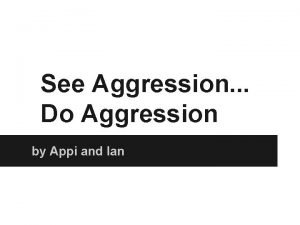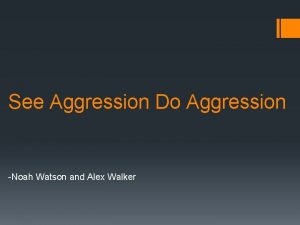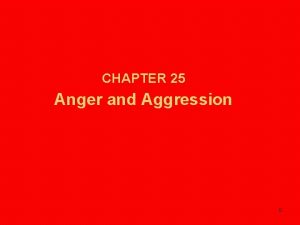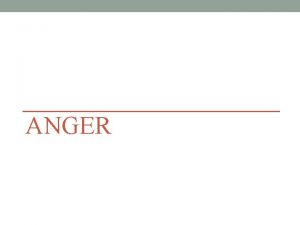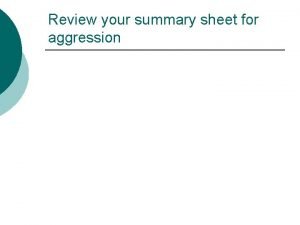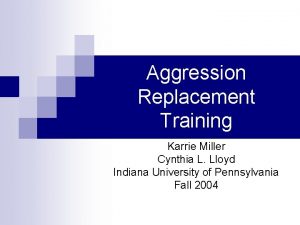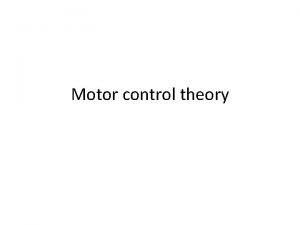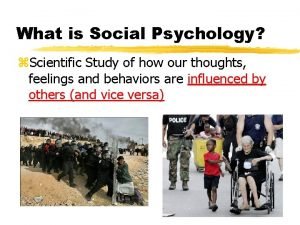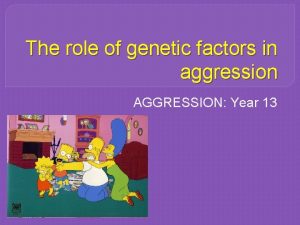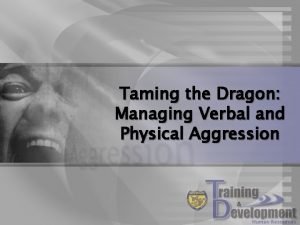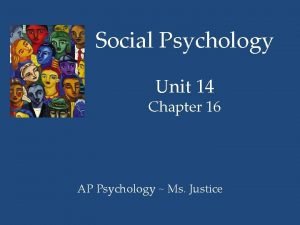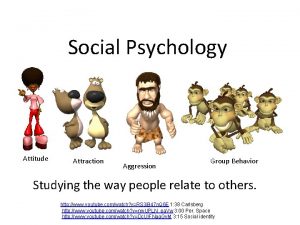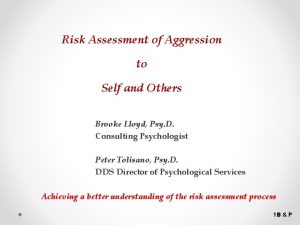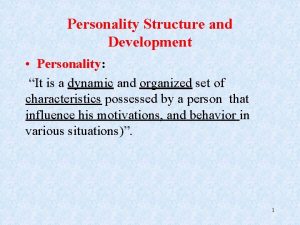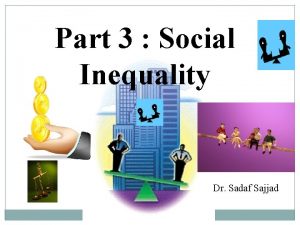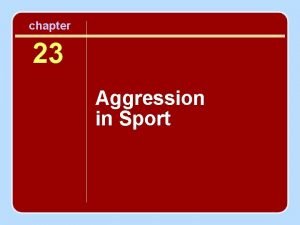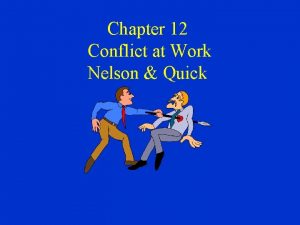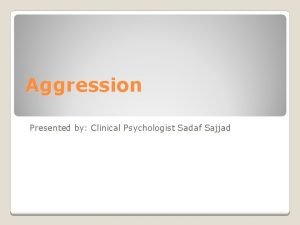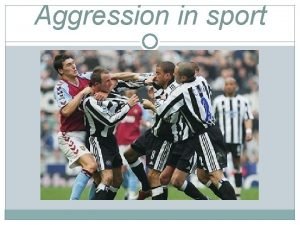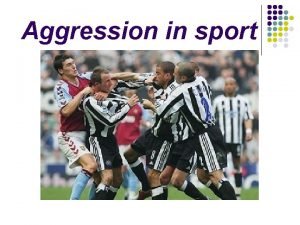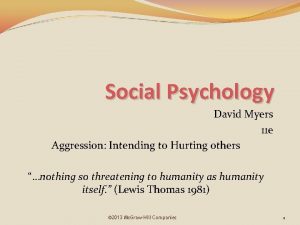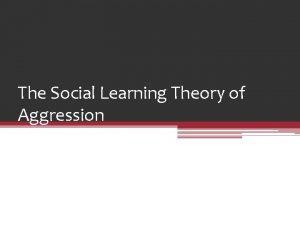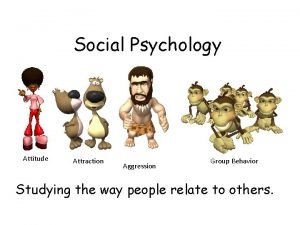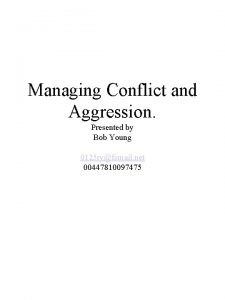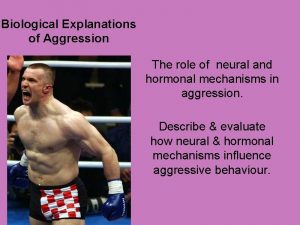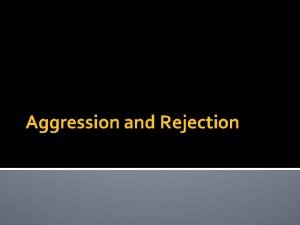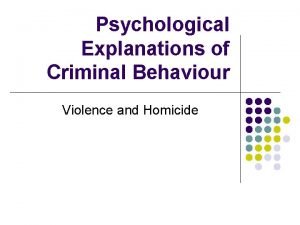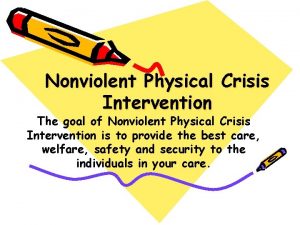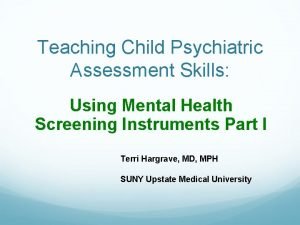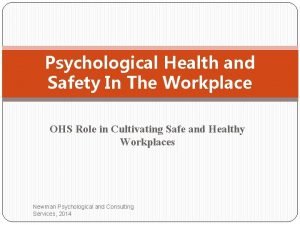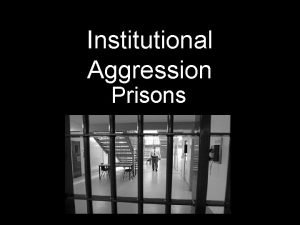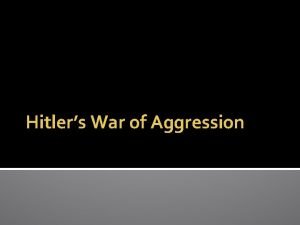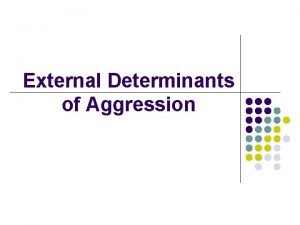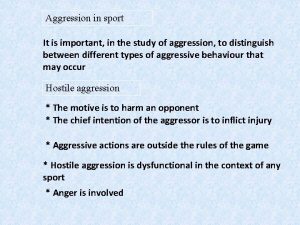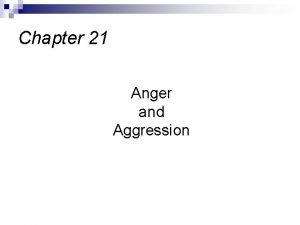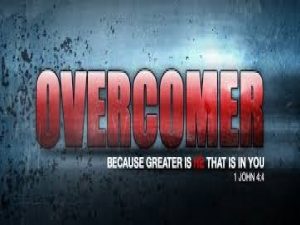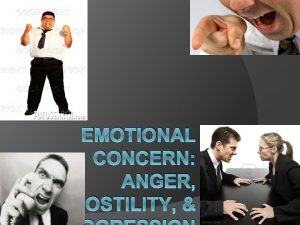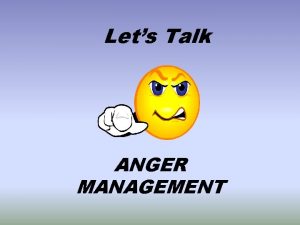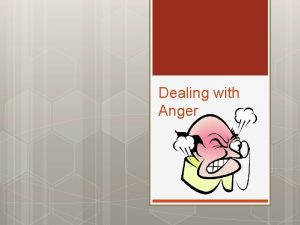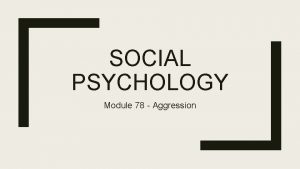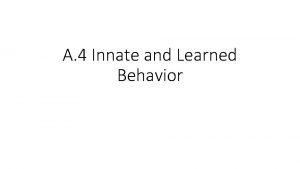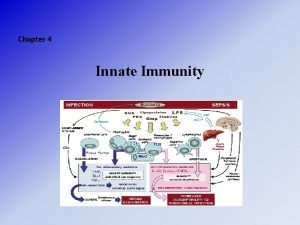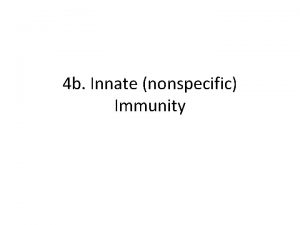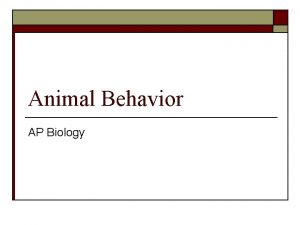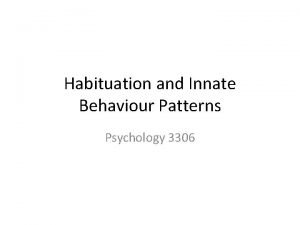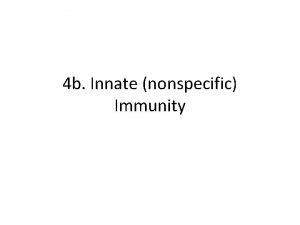ANGER CONTROL TRAINING 1 Theories of Aggression Innate
















































- Slides: 48

ANGER CONTROL TRAINING 1

Theories of Aggression • Innate Drives • Frustration • Learned Behavior 2

Multi-Layered Aggressive behavior, for reasons we will suggest, is typically a difficult behavior to change. 3 For many youths, its teaching is repetitive, its success is frequent, its rewards are generous, and its punishments are few. Aggression Replacement Training®

Aggression is simultaneously a BEHAVIORAL, COGNITIVE and EMOTIONAL phenomenon. So, too, must be the interventions designed to address it. 4

Aggressive behavior can take many forms • Physical Aggression • Verbal Aggression • Relational Aggression • Includes such behaviors as gossiping, spreading cruel rumors, and encouraging others to reject or exclude someone. Aggression Replacement Training®

Aggression: Verbal Injury • Character Attacks “Why can’t you do anything right? ” • Competency Attacks “How could you be so stupid? ” • Background Attacks “You’re just like your father, a loser!” • Physical Appearance Attacks “Must you always look like a slob? ” • Maledictions “You’ll never amount to anything!” 6 Aggression Replacement Training®

Aggression: Verbal Injury • • • Teasing Ridicule Threats Swearing Nonverbal Emblems (Making derogatory faces) 7 Aggression Replacement Training®

Research supports that aggression is learned. Given that AGGRESSION is learned, WHO is teaching it? AND WHERE are they teaching it? 8 Aggression Replacement Training®

Three major classrooms for the learning of aggression • The home • The school • The mass media 9 Aggression Replacement Training®

Development of Aggression In Childhood Coercive Parenting Early Aggression Peer Rejection Social Isolation Attribution of Hostile Intent Affiliation with Antisocial Peer Group Inadequate Social Skills Development Continued High Levels of Aggressive Behavior Patterson, Et Al

Emotional needs met through aggression • Power • Belonging • Freedom • Fun 11 Aggression Replacement Training®

Choosing to meet emotional needs Aggression… …may get others to help us. …may be used as an excuse for our unwillingness to do something more effective. …helps to gain powerful control even if someone is frightened, small, or feels powerless. 12 Aggression Replacement Training®

Aggression as an Addiction • A long term stable behavior, repetitively enacted. • Subjective compulsion to use it. • Reduced ability to control or reduce it, in frequency or intensity. • Frequent relapses involving negative emotional states, interpersonal conflicts, and situations where used before. 13

Aggression as an Addiction • Initiated and sustained by both person and environment. • Yields short-term pleasure despite longterm consequences. • Used in response to, and to relieve, stress, negative mood and general arousal. • Often encouraged and rewarded by peer and family “enablers”. 14

Aggression as an Addiction • Often experienced with a “rush” of pleasure or excitement. • Frequently accompanied by denial (e. g. , attribution of blame). • Preoccupied with others’ use of the behavior (e. g. , aggressive TV viewing). • High rate of health risk, injury, and death. 15

Video games may affect brain activity • Research by the Radiological Society of North America @ Indiana School of Medicine in Indianapolis. • Studied brain activity of teens ages 13 -17, half of whom were diagnosed with disruptive behavior disorder (DBD). Video source: youtube. com 16 • MRI’s showed reduced brain activity in the frontal lobe (controlling thinking, learning, reasoning and emotions). Aggression Replacement Training®

Research has demonstrated a link between exposure to violence in the media and negative outcomes for children, including… • …increased aggressive behavior and attitudes. • …fears or pessimistic attitudes about the world. • …desensitization to both real and fantasy violence. • …increased depression, nightmares and sleep disturbances. Aggression Replacement 17 Training®

Anger Control Training • Discussion of anger and aggression, benefits of controlling anger. • Relabeling of anger and aggression (as weak, immature, counterproductive, etc. ) and nonviolence (as putting youth in a stronger position by giving them options besides fighting). • Expression of a qualifier: The goal is anger management, not to eliminate anger or to convince anyone that fighting is always wrong. 18 Aggression Replacement Training®

Constantly evaluate each client’s: COGNITIVE ABILITY low…………………high EMOTIONAL ABILITY low…………………high SOCIAL ABILITY low…………………. high The level of the client’s ability will have a strong influence on their coping skills 19 Aggression Replacement Training®

Anger Control Training The Emotional Component of ART Original studies conducted by Donald Meichenbaum et al. (1969) looked at the relationship between impulsivity and poor verbal control of overt behavior. 20 Aggression Replacement Training®

What to change? • Could hyperactive, impulsive youngsters be trained systematically to alter their problem-solving styles, to think before they act, or to talk differently to themselves? 21 Aggression Replacement Training®

Overview of a 10 Week Anger Control Training Sequence Week 1: Introduction 1. Explain the goals of Anger Control. 2. Explain the rules for participation. 3. Give initial assessments of the A-B-C’s: A=What led up to it? B=What did you do? C=What were the consequences? 4. Review the entire sequence. 22

Triggers - External - Internal . Self-Evaluation Anger Control Chain - Self-Coaching - Self-Rewarding Thinking Ahead - Short-term Consequences - Long-term Consequences Reminders - 23 - Positive Self-Talk Self Instructional Talk Cues (Physical Signals) Anger Reducers - Count Backwards - Deep Breathing - Pleasant Imagery

Week 2: Triggers(external/internal) Cues Reducers 1. Review the first session. 2. Introduce the Hassle Log. 3. Discuss what makes you angry (triggers). Cues and Reducers. 4. Model triggers, cues , reducers. 5. Review the Hassle Log and Triggers. 24

25 Aggression Replacement Training®

Week 3: Triggers, Cues and Reducers 1. Review the first two sessions. 2. Review chain taught to date – Triggers Cues Reducers. 3. Model – Trigger, Cues Reducers 4. Role-Play triggers + cues + anger reducers. 5. Review the Hassle Log 26

Week 4: Reminders 1. 2. 3. 4. Review the sequence. Introduce reminders. Model using reminders. Role play triggers + cues + anger reducer(s) + reminders. 5. Review reminders. 27

Role Play Triggers: External Internal 28 Cues Anger Reducers Reminders

Week 5: Thinking Ahead 1. Review the sequence. 2. Introduce thinking ahead. • Short and Long term Consequences. • Internal and External Consequences. 3. Role play “if-then” thinking ahead. 4. Role play triggers + cues + anger reducer(s) + reminders + thinking ahead. 5. Review Thinking Ahead. 29

If-Then Thinking = Mental Contrasting THREE STRATEGIES ARE UTILIZED WHEN SETTING GOALS. (DUCKWORTH AND OETTINGEN). TWO DON’T WORK VERY WELL. 30

• Optimists favor indulging, which means imagining the future they would like to achieve. Indulging feels really good when you are doing it but it does not correlate at all with actually achieving your goal. 31

• Pessimists use a strategy called dwelling, which involves thinking about all the things that will get in the way of their accomplishing a goal. 32

• Mental Contrasting combines the other two methods: concentrating on a positive outcome and simultaneously concentrating on the obstacles in their way. 33

Week 6: Self-Evaluation 1. Review the sequence. 2. Introduce self-evaluation: Self-Rewarding Self. Coaching. 3. Role-play triggers + cues + anger reducer(s) + reminders + thinking ahead + self-evaluation. 4. Review self-evaluation. 34

Role Play: If-Then Triggers: External Internal 35 Cues Anger Reducers Reminders Thinking Ahead Self Evaluation

Week 7: Angry Behavior Cycle 1. 2. 3. 4. Review the sequence. Introduce the Angry Behavior Cycle. Identify your own anger-provoking behavior. Change your own anger-provoking behavior. Role-play triggers + cues + anger reducer(s) + reminders. 5. Review the Angry Behavior Cycle. 36

Long’s Conflict Cycle Irrational Beliefs Self. Stress Situation Defeating Increases! Beliefs Feelings Reactions Worsen! Feelings Intensify! Behavior Escalates! 37 Aggression Replacement Training®

Week 8: Rehearsal of Full Sequence 1. Review the sequence. 2. Introduce the use of Skillstreaming skills in place of aggression. 3. Role-play triggers + cues + anger reducer(s) + reminders + thinking ahead +Skillstreaming skills + self-evaluation. 38

Anger Control Self Evaluation Triggers Social Skill EXIT Cues Anger Control Thinking Ahead Anger Reducers Reminders 39 Aggression Replacement Training®

Week 9: Rehearsal of Full Sequence 1. Review the sequence. 2. Role-play triggers + cues + anger reducer(s) + reminders + thinking ahead + Skillstreaming skills + self-evaluation. 40

Week 10: Overall Review 1. Review the Hassle Logs. 2. Recap anger control techniques. 3. Role-play triggers + cues + anger reducer(s) + reminders + thinking ahead +Skillstreaming skills + self-evaluation. 4. Give reinforcement for participation and encourage trainees to continue 41

Triggers - External - Internal . Self-Evaluation Anger Control Chain - Self-Coaching - Self-Rewarding Thinking Ahead - Short-term Consequences - Long-term Consequences Reminders - 42 - Positive Self-Talk Self Instructional Talk Cues (Physical Signals) Anger Reducers - Count Backwards - Deep Breathing - Pleasant Imagery

Anger Control Training Steps Define Model Establish Select Conduct Provide Select Assign 43 • Define the sequence concept • Model the sequence • Establish trainee needs/Review hassle logs • Select role-player assign feedback steps. (bubble talk each step of the sequence) • Select the co-actor • Conduct the role-play • Provide feedback (Order: co-actor, trainees, trainers, main actor) • Select the next role-player

1. Define the sequence concept Clearly define the part of the sequence for the identified session. Assure all participants understand have them give live examples. 44 Aggression Replacement Training®

2. Model the sequence ASSIGN FEEDBACK JUST AS IN SKILLSTREAMING. BUBBLE TALK EACH STEP OF THE CHAIN AND THEN ROLE PLAY THE SCENARIO. 45 Aggression Replacement Training®

Anger Control Steps 3 -9 Establish Select Conduct Provide Select • Establish trainee needs/Review hassle logs • Select role-player assign feedback steps (bubble talk each step of the sequence) • Select the co-actor • Conduct the role-play • Provide feedback (Order: co-actor, trainees, trainers, main actor) • Select the next role-player Assign 46 Aggression Replacement Training®

47 Aggression Replacement Training®

48 Aggression Replacement Training®
 Aggression replacement training anger control chain
Aggression replacement training anger control chain Behavior chain
Behavior chain See aggression do aggression
See aggression do aggression See aggression do aggression
See aggression do aggression Chapter 27 anger aggression and violence
Chapter 27 anger aggression and violence Stages of assault cycle
Stages of assault cycle Anger vs aggression
Anger vs aggression Aggression replacement training facilitator training
Aggression replacement training facilitator training Theories of agression
Theories of agression Karrie miller
Karrie miller Hierarchy theory of motor control
Hierarchy theory of motor control Self fulfilling prophecy
Self fulfilling prophecy Outline the role of genetic factors in aggression
Outline the role of genetic factors in aggression Examples of verbal aggression
Examples of verbal aggression Normative social influence ap psychology
Normative social influence ap psychology Frustration aggression principle
Frustration aggression principle Mauritania white moors
Mauritania white moors Types of aggression in psychology
Types of aggression in psychology Aggression risk assessment
Aggression risk assessment Laughter as a defense mechanism
Laughter as a defense mechanism Sadaf sajjad
Sadaf sajjad Instinct theory in sport
Instinct theory in sport Incompatible goals
Incompatible goals Example of direct aggression
Example of direct aggression Instrumental aggression
Instrumental aggression Aggression cues examples
Aggression cues examples Hostile aggression
Hostile aggression Social determinants of aggression
Social determinants of aggression International response to german aggression
International response to german aggression Supportive stance meaning
Supportive stance meaning Aggression in the pacific map
Aggression in the pacific map Social learning theory of aggression
Social learning theory of aggression Group aggression
Group aggression Big bob agression
Big bob agression Biological explanations of aggression
Biological explanations of aggression Effects of aggression
Effects of aggression Expressive aggression
Expressive aggression 3 reasons to use supportive stance
3 reasons to use supportive stance Modified overt aggression scale score interpretation
Modified overt aggression scale score interpretation Aggression nature vs nurture
Aggression nature vs nurture Fear factory aggression continuum
Fear factory aggression continuum Germany map
Germany map The importation model
The importation model Nazi aggression map
Nazi aggression map Cognitive neoassociation
Cognitive neoassociation Aggression cycle
Aggression cycle Hypnose aggression
Hypnose aggression Deindividuation theory
Deindividuation theory Frustration aggression theory in sport
Frustration aggression theory in sport
